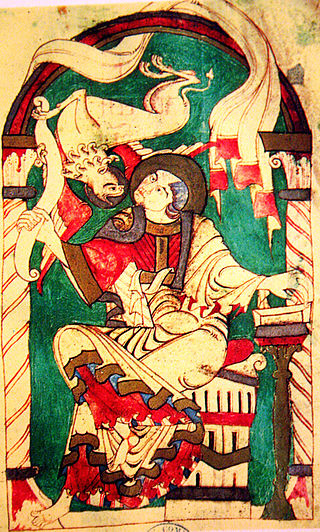
Codex Augiensis, designated by Fp or 010, α 1029 is a 9th-century diglot uncial manuscript of the Pauline Epistles in double parallel columns of Greek and Latin on the same page.

Codex Basilensis A. N. IV. 2, known as Minuscule 1, δ 254, and formerly designated by 1eap to distinguish it from minuscule 1rK is a Greek minuscule manuscript of the entire New Testament, apart from the Book of Revelation. Using the study of comparative writings styles (palaeography), it is usually dated to the 12th century CE.
The Codex Vindobonensis Lat. 1235, designated by i or 17, is a 6th-century Latin Gospel Book. The manuscript contains 142 folios. The text, written on purple dyed vellum in silver ink, is a version of the old Latin. The Gospels follow in the Western order.

The Codex Veronensis, designated by siglum b or 4, is a 5th century Latin Gospel Book. The text, written on purple dyed vellum in silver and occasionally gold ink, is a version of the old Latin. The Gospels follow in the Western order.
The Codex Palatinus, designated by e or 2, is a 5th-century Latin Gospel Book. The text, written on purple dyed vellum in gold and silver ink, is a version of the old Latin. Most of the manuscript was in the Austrian National Library at Vienna until 1919, when it was transferred to Trento, where it is now being kept as Ms 1589 in the Library of Buonconsiglio Castle. Two leaves were separated from the manuscript in the 18th century: one is now in the library of Trinity College, Dublin, the other in the British Library in London.

The Codex Corbeiensis I, designated by ff1 or 9, is an 8th, 9th, or 10th-century Latin New Testament manuscript. The text, written on vellum, is a version of the old Latin. The manuscript contains 39 parchment folios with the text of the four Gospels, Acts of the Apostles, and General epistles.
The Codex Corbeiensis II, designated by ff2 or 8, is a 5th-century Latin Gospel Book. The text, written on vellum, is a version of the old Latin. The manuscript contains 190 parchment folio with the text of the four Gospels with lacunae. Written in a beautiful round uncial hand.
The Codex Curiensis known also as Fragmenta Curiensia, designated by a2 or 16, is a 5th-century AD Latin manuscript of the New Testament. The text, written on vellum, is a version of the old Latin. The manuscript contains the fragments of the Gospel of Luke, on exactly two parchment leaves.
The Codex Mediolanensis or Fragmentum Mediolanense, designated by g2 or 52, is a 10th or 11th century Latin manuscript of the New Testament. The text, written on vellum, is a version of the Vetus Latina. The manuscript contains the fragments of the Gospel of Luke, on only 2 parchment leaves. It was a lectionary.
The Codex Sangermanensis I, designated by g1 or 7, is a Latin manuscript, dated AD 822 of portions of the Old Testament and the New Testament. The text, written on vellum, is a version of the Latin. The manuscript contains the Vulgate Bible, on 191 leaves of which, in the New Testament, the Gospel of Matthew contain Old Latin readings. It contains Shepherd of Hermas.
The Codex Bernensis known also as Fragmenta Bernensia, designated by t or 19, is a 5th or 6th century Latin manuscript of the New Testament. The text, written on vellum, is a version of the old Latin. The manuscript contains the fragments of the Gospel of Mark, on only 2 parchment leaves. Written in two columns per page, 23 lines per column. It is a palimpsest.

Codex Carolinus is an uncial manuscript of the New Testament on parchment, dated to the 6th or 7th century. It is a palimpsest containing a Latin text written over a Gothic one. The Gothic text is designated by siglum Car, the Latin text is designated by siglum gue or by 79, it represents the Old Latin translation of the New Testament. It is housed in the Herzog August Library in Wolfenbüttel in Lower Saxony, Germany.
The Codex Floriacensis, designated by h in traditional system or by 55 in the Beuron system, is a 6th-century Latin manuscript of the New Testament. The text, written on vellum, is a palimpsest. Another name of the manuscript is Fleury Palimpsest or Palimpsestus Floriacensis. It is one of the eight Old-Latin manuscripts with text of Apocalypse.
The Codex Sangermanensis II, designated by g2 or 29, is a 10th-century Latin manuscript of the New Testament. The text, written on vellum, is a version of the Latin.
The León Palimpsest, designated l or 67, is a 7th-century Latin manuscript pandect of the Christian Bible conserved in the cathedral of León, Spain. The text, written on vellum, is in a fragmentary condition. In some parts it represents the Old Latin version, while following Jerome's Vulgate in others. The codex is a palimpsest.
Minuscule 890, Θε426, is a 14th-century Greek minuscule manuscript of the New Testament on paper, with a commentary. It was prepared for liturgical use.

Minuscule 922, δ 200, is a 12th-century Greek minuscule manuscript of the New Testament on parchment. It has marginalia. The manuscript has survived in complete condition.

Minuscule 1187, ε 1083, is an 11th-century Greek minuscule manuscript of the New Testament on parchment. It has marginalia. The manuscript has survived in complete condition. It is housed in the Saint Catherine's Monastery.
Minuscule 933, ε 2004, is a 12th-century Greek minuscule manuscript of the New Testament on parchment. It has liturgical books, marginalia and was prepared for liturgical use. The manuscript has not survived in complete condition.
Minuscule 935, δ 361, is a 14th-century Greek minuscule manuscript of the New Testament on parchment. It has marginalia and was prepared for liturgical use. The manuscript has survived in complete condition.






